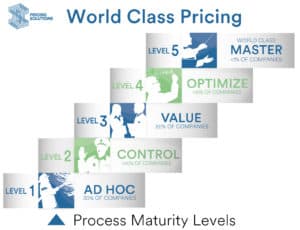by Kirk Jackisch, President at Pricing Solutions & Paul Hunt, Chairman at Pricing Solutions
Increasing the value of your private equity firm’s portfolio can be a complex endeavor. There are multiple levers to be pulled such as financing, product/service fit, human capital, operational transformation, technology, etc. Yet one area of high EBITDA leverage that is consistently overlooked by Private Equity managers is pricing.
The Hidden 10X EBITDA Multiplier
Given that EBITDA is a primary driver of your company valuation, it makes sense to focus on the drivers with the greatest leverage on EBITDA to maximize investment returns.
Analysis across thousands of Private Equity investments shows that the EBITDA leverage of an improvement in pricing typically impacts EBITDA by 10-12X. In comparison, a reduction in fixed or variable costs for the average PE investment has 2-5X leverage on EBITDA.
When you achieve a 2% effective price increase with no volume drop, this normally yields a 25% increase in EBITDA. This 10-12X EBITDA leverage from top-line price optimization is much higher than the 2-5X EBITDA effect of reducing costs.
Given the high valuation impact of pricing, why don’t your Private Equity firm focus on pricing optimization for its portfolio companies?
The Five Levels of World Class Pricing
Private Equity firms typically invest in a company after years of underperformance that have left the company with many challenges (and opportunities). Pricing is typically seen as a quick win, but underlying those quick wins is a muddled pricing strategy and value proposition.
Your firm’s management team are not pricing experts and as a result, do not know how to systematically go about capturing the full pricing opportunity. Instead, your company’s pricing strategy may be based on cost-plus tradition and skewed guidance from sales teams. This is rudimentary at best.
Effective pricing strategy can be broken down into five levels:

Level 1: Firefighting
A large percentage of companies are perpetually in Firefighting mode with their pricing. The pricing strategy is non-existent and their sales force is out of control. The relationship between price, volume and customer value is scattered randomly. Sophisticated purchasing departments drive the price negotiation process. The sales team is continuously pushed against quarterly deadlines and forced to discount to close sales. The best negotiators get the best price. The company loses money on a large number of accounts due to low pricing, hidden costs and rampant discounting.
Level 2: Policing
The next level is Policing. Private Equity companies typically install a strong finance person to play the cop. A large amount of value is available to extract by Private Equity investors by simply getting the pricing process under control. To gain control a structured pricing process is implemented with Finance directly involved in and managing pricing. A pricing book may be in place, and Sales is provided some guidance on volume discounting. Pricing may still be based on a cost-plus model. A few Excel spreadsheets and perhaps even pricing software are used to control the process. It’s a quantum jump over Stage 1, but the company’s pricing is based on costs and target margins which is still sub-optimal and non-scientific.
Level 3: Partnering
Few companies reach this level on their own. It’s a big paradigm shift over Stage 2 and involves pricing according to the value to the buyer. Most Private Equity companies want their portfolio companies to get to Level 3 but don’t have the processes and tools to drive the change needed to get there. Portfolio companies may invest in a Value Selling or Challenge Selling program for their sales team to take a “value partner” stance in an effort to support higher prices, but that is insufficient to get to Level 3. Typically, the pricing strategy must be redesigned using micro-segmentation, voice of the customer research, sales force training and KPIs to ensure the transformation to level 3 is successful. Getting to this level has significant and repeatable long-term benefits to EBITDA.
A Private Equity firm that takes its portfolio companies all the way through Level 3 pricing can expect 10-12X EBITDA leverage. We typically see a 25% increase in EBITDA for a 2% increase in revenue through the optimization process.
Level 4: Optimizing
In the age of AI and machine learning Level 4 will become increasingly common and a competitive necessity. This is particularly true in industries that have rich data sources that can be leveraged by pricing scientists. Restaurants, retail, online are all examples of industries for which Level 4 is a competitive imperative and for which there are rich rewards to be gained from getting there.
Level 5: Mastery
This stage is achieved when the company has optimized pricing for every product/service and customer based on value and hard data. Companies that achieve pricing mastery effectively unlock all the available value in their market, and generate much greater EBITDA and valuation numbers than their competitors.
The Positive Impact of Prioritizing Price
I call price “the iceberg” of the organization because it doesn’t appear that important on the surface, but when you take a deeper look you realize the massive effect it has on business profitability. Not only do investors benefit from 10-12X EBITDA leverage, but shareholders keep the value, with every transaction leading to higher EBITDA and long-term firm value.
How insidious is this “iceberg effect”? Consider this: we typically see discounts from list/quote price to invoice price of around 20-25%. But that’s not all. We also see an additional 20-25% discount from invoice price to “in our pocket” price due to a raft of hidden discounts, volume concessions, unnecessary just-in-time delivery schedules, last-minute change orders, etc. These are costs that have near-zero visibility and kill the bottom line.
By investing in an effective pricing program, you can highlight these hidden costs and drive them down through the use of profit-oriented KPIs, along with increasing top-line revenues. The net result is significantly higher EBITDA and company value.
Managers will often quote “market forces” as to why a company’s pricing structure is the way it is. This is a purely reactive mode and does not address the underlying incentives and lack of sophistication that lead to poor pricing strategy. Sales teams have become acclimated to powerful procurement teams and expect to give discounts and a host of other hidden (and costly) concessions at the end of every quarter.
By focusing on the pricing strategy of the portfolio companies, Private Equity investors can generate multiples upon multiples of additional value.





